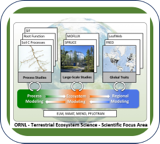CO2 refixation is higher in leaves of woody species with high mesophyll and stomatal resistances to CO2 diffusion
| Author | |
|---|---|
| Keywords | |
| Abstract |
Abstract The percentage of respiratory and photorespiratory CO2 refixed in leaves (Pr) represents part of the CO2 used in photosynthesis. The importance of Pr as well as differences between species and functional types are still not well investigated. In this study, we examine how Pr differs between six temperate and boreal woody species: Betula pendula, Quercus robur, Larix decidua, Pinus sylvestris, Picea abies and Vaccinium vitis-idaea. The study covers early and late successional species, deciduous broadleaves, deciduous conifers, evergreen conifers and evergreen broadleaves. We investigated whether some species or functional types had higher refixation percentages than others, whether leaf traits could predict higher Pr and whether these traits and their impact on Pr changed during growing seasons. Photosynthesis CO2 response (A/Ci)-curves, measured early, mid and late season, were used to estimate and compare Pr, mesophyll resistance (rm) and stomatal resistance (rs) to CO2 diffusion. Additionally, light images and transmission electron microscope images were used to approximate the fraction of intercellular airspace and cell wall thickness. We found that evergreens, especially late successional species, refixed a significantly higher amount of CO2 than the other species throughout the entire growing season. In addition, rm, rs and leaf mass per area, traits that typically are higher in evergreen species, were also significantly, positively correlated with Pr. We suggest that this is due to higher rm decreasing diffusion of (photo) respiratory CO2 out of the leaf. Cell wall thickness had a positive effect on Pr and rm, while the fraction of intercellular airspace had no effect. Both were significantly different between evergreen conifers and other types. Our findings suggest that species with a higher rm use a greater fraction of mitochondria-derived CO2, especially when stomatal conductance is low. This should be taken into account when modeling the overall CO2 fertilization effect for terrestrial ecosystems dominated by high rm species. |
| Year of Publication |
2021
|
| Journal |
Tree Physiology
|
| Volume |
41
|
| Issue |
8
|
| Number of Pages |
1450-1461
|
| ISSN Number |
1758-4469
|
| DOI |
10.1093/treephys/tpab016
|
| Download citation |

